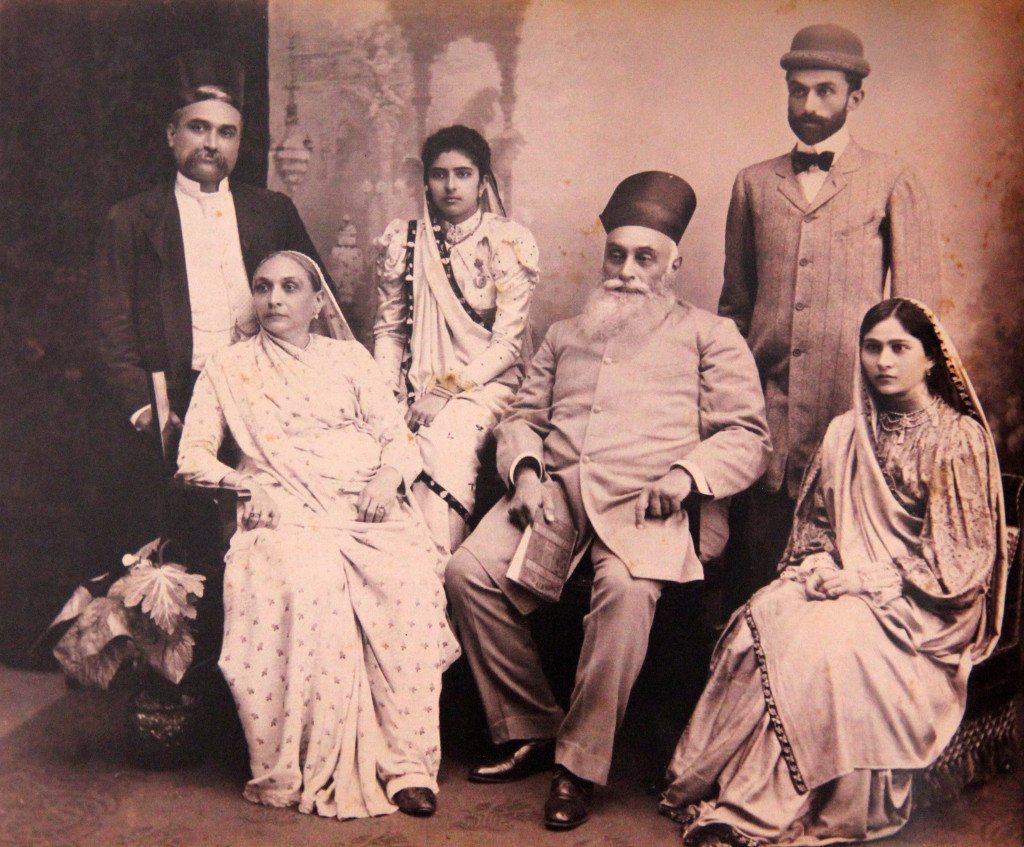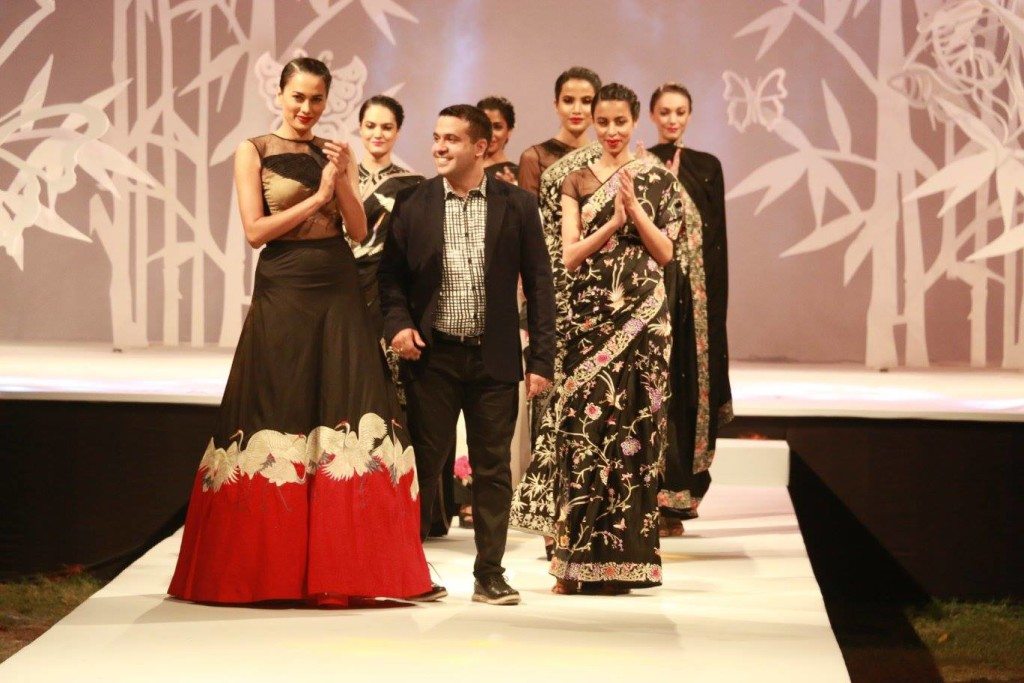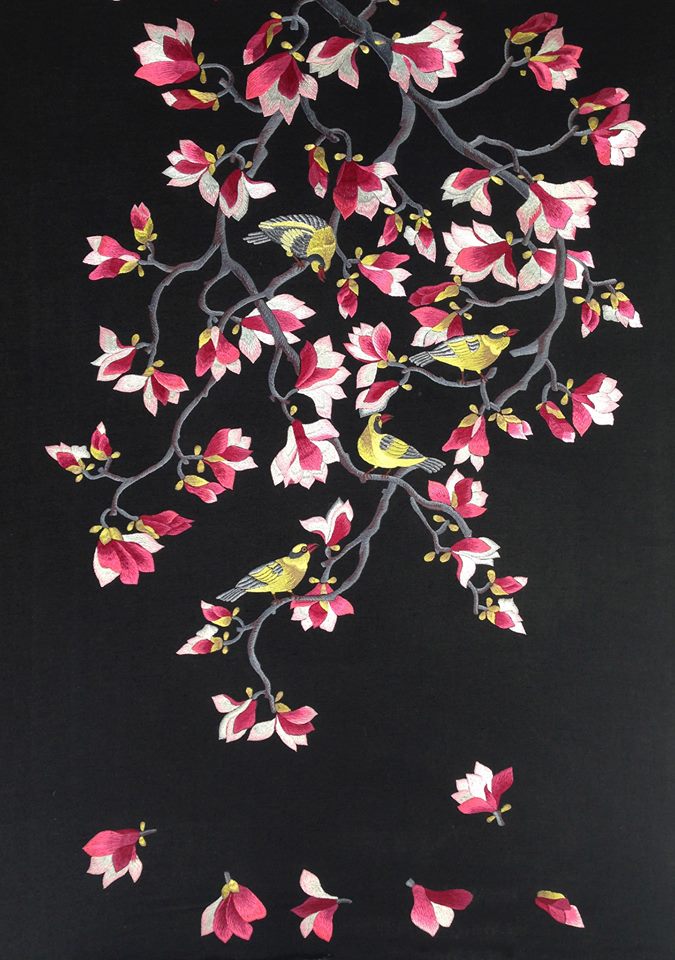6652 people reached on Lassi with Lavina FB page
507 views on LinkedIn – 8 Likes
Yashna Maya Padamsee, Gulnaaz Lalji and Puja Thomas-Patel liked it on Lassi with Lavina FB page

Ashdeen: Embroidering Surreal Parsi Dreamscapes
Few things are as beautiful or have such a convoluted history as Parsi Gara – the gorgeous embroidery which came to India by way of Persia and China through the Parsi traders dealing in opium in China. These traders who journeyed to China in the 19th century discovered distinct hand-embroidery and carried it back to India.
Noted designer, author and curator Ashdeen Lilaowala who is Parsi, has spent almost a decade traveling to Iran and China to trace the back story of this fabulous embroidery which is a fusion of Parsi, Indian, European and Chinese crafts and aesthetics. Ashdeen has become a major name in the fashion world in India and his embroidery has been seen at the Lakme Fashion Week as well as on stars like Madhuri Dixit, Hema Malini and Sonam Kapoor.
Recently Ashdeen was on his first trunk show in the US and first showed in Los Angeles at the Zoroastrian Association of California. In New York and New Jersey his shows were organized by the Zoroastrian Association of Greater New York (ZAGNY). At the reception at DAG Gallery in Manhattan, he gave a fascinating illustrated talk through which he took the audience back to British times, back to pre-Independence days when enterprising Parsis went to Hong Kong and China and created the special embroidery known as Parsi Gara. Many Parsis from the tri-state area had turned up for this rich encounter with their roots and heritage.
The Parsis, a vibrant and unique community in India, are descended from the Zoroastrians who fled religious persecution in Persia 1200 years ago and found a warm and welcoming home in India. The womenfolk adopted the sari when they landed in India in keeping with their promise to the local ruler that they would wear the traditional clothes of the land. Old photographs show them wearing the heavily embroidered silk saris with the distinctive work known as Parsi Gara. As Ashdeen notes, the Parsis inherited this legacy only after they started the trade with China. These special embroideries are not found in other Indian communities and were embraced by the Parsi community to create their own identity.


China had been planting tea for hundreds of years but during the British days it became a very popular beverage and export to the west. Since foreign traders were not allowed into mainland China and could only go as far as Canton, the British used Parsi traders for this job. The product they took for export from India was opium. So this became a tri-party trade with the British happily collecting tax on tea and opium, and the unique embroideried silk fabrics became a by-product of this tea and opium trade with China.
These silk saris used a lot of the traditional Chinese colors such as purple, black and red and all the embroideries were inspired by the Orient, with intricate detailing of flowers, animals and birds. One of the most popular motifs was the peacock, which is equally loved in Indian, Chinese and Persian mythology. Another popular design was cranes which were highly regarded in China and reserved for the emperor and high ranking officials. In China, the art was very realistic so the cranes actually looked as if they were taking flight. Yet another popular motif in China was the fish and the Parsis too consider it auspicious and lucky so it found its way not only into the saris but also into rangoli designs. Fish of course is one of the popular Parsi foods and as Ashdeen mentioned, they actually carried a fish along to Parsi weddings!
Flowers are embroidered in Gara work and this includes Chrysanthemums which were always used for emperors in China. Birds and butterflies are used profusely in Chinese embroidery and the Parsis adapted them into the Gara work. Ashdeen related a charming story of how the multicolored butterflies came to populate Parsi saris. A worker told the person commissioning the saris that he had lots of different colored threads left over but not enough to make a full sari. He was told to use these random threads to fill in the butterflies, no matter what color of thread it was and no two butterflies should be the same. The result was a whole cacophony of butterflies with multi-hued wings, a delight on the canvas of the sari. So every sari has a story embroidered into it.

One motif is highly auspicious in China but abhorred in India – the bat. Ashdeen recalled a Parsi woman who absolutely refused to wear the sari when she realized it had bats embroidered on it! An interesting aspect of the old Parsi saris is that a corner of the pallau of the sari was tucked into the back for convenience and since that portion was hidden it had no embroidery on it for economic reasons. Now the saris are no longer worn in that style by the new generation and they desperately try to get that empty corner in the heritage saris embroidered!
Ashdeen Explains the Magic of Parsi Gara
Now time has moved on: the ancient Chinese kingdoms, the old British Raj and the Parsi traders of those days have all disappeared. Even the original Parsi Gara saris are a rare find, a family heirloom.
Thanks to contemporary designers and craftspeople, the art of Parsi Gara remains even today, like a fabulous and vibrant tapestry, spreading its roots and becoming an intricate and popular part of the Indian fashion industry. It is seen not only in high-end fashion events that define the trends of the fashion industry, but in the wedding celebrations of varied communities, making it a part of the social life in India. Today there are master embroiderers who can still replicate those intricate designs.
For the Parsi community Ashdeen is a keeper of the culture. Both mothers and daughters love the Parsi Gara work and want it in their families for the future. His recent trip to the US was facilitated by Zoroastrian organizations across the US, and a portion of the proceeds will go to ZAGNY for the upkeep of its new Dar-E-Mehr Temple in upstate New York. His creations can be purchased in the US at www.zagny.org/ashdeen.
In a way, Ashdeen is an oral and visual story-teller of the Parsi community who makes sure the unmatched art of Parsi Gara can be resurrected for future generations. Through his detailed and rich designs one can touch the past and make it an ongoing part of the present and the future.

Face to Face with Ashdeen
Ashdeen Z. Lilaowala is a textile designer, author and curator, as well as a lecturer at the National Institute of Fashion Technology (NIFT), New Delhi. A graduate in Textile Design from National Institute of Design (NID), Ahmadabad, he is the author of Threads of Continuity – The Zoroastrian Craft of Kusti Weaving.
In 2012, Ashdeen launched his label specializing in hand embroidered saris. His embroidered cocktail dresses, gowns and saris are noted for a contemporary, unique take on the traditional Parsi Gara embroidery. ELLE magazine voted him as “The hottest design talent of 2013” and awarded him for his excellence in reviving embroidery.
Ashdeen creates custom embroideries for clients in Europe and America at his atelier in New Delhi, and celebrities like Mariah Carey and Beyonce have worn his hand-embroidered creations.
Did you grow up within Bombay’s Parsi community and what were the influences on your childhood?
I grew up in a Parsi Baug (colony), went to a school which was founded by Parsis and had several Parsi teachers, had a Parsi athletics coach and also went for Parsi scouts- there was plenty of Parsi influence growing up!
What were your key influences in design?
My elder brother started studying fashion design when I was in school and that triggered an interest in the world of design and fashion. As a teenager in the 90s, the newly launched cable television was great exposure for us. Music videos on MTV and American soap-operas like Santa Barbara and Bold & The Beautiful were a huge influence.
Did you have any idea that one day you would be a textile designer and tell stories through embroidery?
Only in Junior college did I realize that I wanted to do something in design. I had no idea how to go about it and have to thank my parents for guiding me to apply to NID.
India has such a rich history of craft and design – your thoughts on it?
India has a fantastic heritage of crafts and design. I think young Indian designers are lucky to have so many resources – be it weavers, embroiderers and talented artisans across the nation. It is important for us to value and respect this rich heritage and the women and men who have kept alive the many traditions in their infallible hands.

Many years back Indians would crave foreign saris – nylons and satin ones from the Far East. Do you think they now value their own riches?
I think there is a new fervor to value and cherish our Indian crafts. It’s reassuring to see young women wearing and appreciating their saris. As more and more knowledge is disseminated about crafts through various platforms, it is creating an educated connoisseur who may be buying less but truly cherishes the crafts they buy.

Your designs are surreal, plucked from a fantasy world. The inspiration behind them?
Our inspiration is always The Orient – we like to pick different themes and ideas each season and explore them. Inspiration comes from various platforms – music, art and even random daily events.
What’s the process behind an Ashdeen garment?
We generally start with a theme board – full of visual references. We slowly narrow down on some ideas which are then explored at length. My team and I, each season, select a few motifs and colors which we feel would be ideal. We sample all our designs and work on the different color combinations for the final saris and accessories.

What are your future plans?
I would like to open a store in Delhi or Bombay for our collection and also promote other Parsi crafts and traditions
Which is your most treasured embroidered textile?
I have been collecting antique Parsi textiles for the last decade, and have a few exquisite embroidered borders, which I truly cherish.
The rewards of what you do?
I think it is very rewarding to see your creations being worn by a bride at her wedding!
The Parsis are a small community – can the Parsi Gara embroidery live forever?
I am very wishful that the community and craft will survive for eternity. Parsi Gara work is a rich heritage not only of our minuscule community but a vibrant strand of the rich tapestry of Indian textiles.
An appreciation from a reader

Ameera Ahmed: Thank you for writing this! This is me at five months pregnant in a Parsi Gara sari. I will of course be saving this for my darling little girl. I always wanted to learn the history.
Lassi with Lavina: What a lovely sari! You are lucky to have this heirloom in your family to pass on to the next generation!



7 Comments
Hi Lille, thanks for your comment. Yes, enjoyed meeting Ashdeen and learning so much about Parsi Gara.
Hello, thank you for the article and video, it is so vividly described. I didn’t know you were there or would have said hello. I had asked a few friends over who love embroideries and textiles, it was sooooooo busy. Hope you bought something for yourself, such ravishing attire!!!!!!
Thanks Ashdeen Lilaowala – readers have loved the article! I really enjoyed your talk and tried to share the magic and mystery of Parsi Gara in my feature. You have to do a repeat visit soon!
Pingback: Ashdeen: Embroidering Surreal Parsi Dreamscapes | Parsi Khabar
Via Google + India Group
Subodh Pandey +1’d
Osmarina Ribeiro +1’d
Shirley Smith +1’d
Via Google + Fashion Bloggers Group
Adriana Gaona +1’d
Dana Hajji +1’d
David LeBlanc +1’d
Sharlyn Duktan +1’d and commented
лина кириллова +1’d